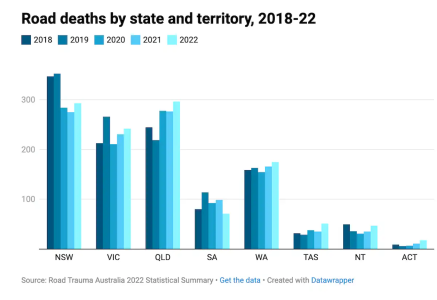Are Australia’s roads becoming more dangerous? Here’s what the data says
- Replies 3
In 2022, there were nearly 1,200 road crash deaths in Australia – a figure that has remained largely the same over the past decade. However, some states and territories have seen dramatic increases in just the last five years, such as the ACT (100%), Tasmania (59.4%) and Queensland (21.2%).
Serious injuries from road crashes have also been on the rise, from 35,000 in 2013 to 39,866 in 2019.
These statistics highlight the need for an urgent rethink of road safety policies if we are to achieve Australia’s target of a 50% decrease in fatalities and a 30% decrease in serious injuries by 2030. We are clearly not on track to meet these targets.
People are worth more than statistics, though. And it is not surprising we haven’t seen decreases in road deaths when we rely on strategies first implemented three to four decades ago. Change is needed to prevent the ongoing trauma caused by road crashes to Australian families.
These initiatives have been highly successful in reducing road deaths from their peak in 1970, when 3,798 were recorded. But in the past two decades, further progress has stalled. We must ask ourselves why.
One theory to explain why road deaths may have increased in many states in the past couple of years is the pandemic. The previously empty roads are now congested again, which may have led to impatience and speeding. Or perhaps, some people have seemingly forgotten how to drive safely. However, there is another, perhaps simpler explanation.
This chart shows how closely road deaths have tracked with domestic fuel sales in Australia – measured in millions of litres of fuel – since 2019. In simple terms, when driving rates decreased at the beginning of the pandemic, deaths and injuries went down. When driving rates increased again in early 2021, deaths and injuries went up.

In fact, there is scant evidence to suggest people’s driving behaviours changed during this time. Our recent unpublished research followed approximately 800 drivers from January 2020 to March 2023 using monitoring systems inside their cars to measure their behaviour. We found no differences in driver behaviours during this time.
Rather, there’s a more likely reason why road deaths and injuries continue to be so high: the amount of time we spend driving continues to increase, while our strategies to target the risks associated with driving haven’t changed.
Unfortunately, government agencies continue to rely on strategies implemented over the past 20-30 years, which were effective when they were first introduced, but are now subject to the law of diminishing marginal returns. This means continually throwing more resources at existing speed management strategies, for example, will likely only see marginal benefits.
For example, a recent Australian trial using new driving monitoring technology showed promise in reducing risky driving behaviours that could cause crashes. The monitoring systems provided feedback to the driver (via a smartphone app) and encouraged safer driving using financial incentives akin to insurance premiums. This new strategy is being explored further in three states: New South Wales, Queensland and Western Australia.
Encouraging people to transition from private car trips to public transport is another road safety strategy that has seldom been considered by governments. Rather, the driver, car and road remain the focus.
This “safe system” approach puts an emphasis on building safe road infrastructure for cars, while ignoring urban design changes that de-emphasise the need for cars. We should be encouraging more people to commute by rail, tram and bus (all lower-risk modes per kilometre travelled), while at the same time delivering safe infrastructure for sustainable transport such as bicycles/e-bicycles or walking.
If we continue to tinker with strategies implemented many decades ago, we will never get close to achieving the lofty government targets on road deaths and injuries by 2030.
This article was first published on The Conversation, and was written by Mark Stevenson, Professor of Urban Transport and Public Health, The University of Melbourne, Jason Thompson, Associate Professor, Faculty of Medicine and Melbourne School of Design, The University of Melbourne
Serious injuries from road crashes have also been on the rise, from 35,000 in 2013 to 39,866 in 2019.
These statistics highlight the need for an urgent rethink of road safety policies if we are to achieve Australia’s target of a 50% decrease in fatalities and a 30% decrease in serious injuries by 2030. We are clearly not on track to meet these targets.
People are worth more than statistics, though. And it is not surprising we haven’t seen decreases in road deaths when we rely on strategies first implemented three to four decades ago. Change is needed to prevent the ongoing trauma caused by road crashes to Australian families.
Why have road trauma rates not declined?
Australia has long had an international reputation for pioneering road safety measures, such as seat belt restraints, speed management strategies (including speed cameras) and drink-driving laws, among others. In fact, Australia was the first countryin the world to introduce laws for compulsory seat belt use.These initiatives have been highly successful in reducing road deaths from their peak in 1970, when 3,798 were recorded. But in the past two decades, further progress has stalled. We must ask ourselves why.
One theory to explain why road deaths may have increased in many states in the past couple of years is the pandemic. The previously empty roads are now congested again, which may have led to impatience and speeding. Or perhaps, some people have seemingly forgotten how to drive safely. However, there is another, perhaps simpler explanation.
This chart shows how closely road deaths have tracked with domestic fuel sales in Australia – measured in millions of litres of fuel – since 2019. In simple terms, when driving rates decreased at the beginning of the pandemic, deaths and injuries went down. When driving rates increased again in early 2021, deaths and injuries went up.

12-month rolling average of domestic fuel consumption per month in millions of litres per year vs road deaths per month since 2019.
In fact, there is scant evidence to suggest people’s driving behaviours changed during this time. Our recent unpublished research followed approximately 800 drivers from January 2020 to March 2023 using monitoring systems inside their cars to measure their behaviour. We found no differences in driver behaviours during this time.
Rather, there’s a more likely reason why road deaths and injuries continue to be so high: the amount of time we spend driving continues to increase, while our strategies to target the risks associated with driving haven’t changed.
Unfortunately, government agencies continue to rely on strategies implemented over the past 20-30 years, which were effective when they were first introduced, but are now subject to the law of diminishing marginal returns. This means continually throwing more resources at existing speed management strategies, for example, will likely only see marginal benefits.
A new approach not focused on cars
There is increasing urgency to investigate and implement new road safety strategies based on emerging technologies and a redesign of our cities instead.For example, a recent Australian trial using new driving monitoring technology showed promise in reducing risky driving behaviours that could cause crashes. The monitoring systems provided feedback to the driver (via a smartphone app) and encouraged safer driving using financial incentives akin to insurance premiums. This new strategy is being explored further in three states: New South Wales, Queensland and Western Australia.
Encouraging people to transition from private car trips to public transport is another road safety strategy that has seldom been considered by governments. Rather, the driver, car and road remain the focus.
This “safe system” approach puts an emphasis on building safe road infrastructure for cars, while ignoring urban design changes that de-emphasise the need for cars. We should be encouraging more people to commute by rail, tram and bus (all lower-risk modes per kilometre travelled), while at the same time delivering safe infrastructure for sustainable transport such as bicycles/e-bicycles or walking.
If we continue to tinker with strategies implemented many decades ago, we will never get close to achieving the lofty government targets on road deaths and injuries by 2030.
This article was first published on The Conversation, and was written by Mark Stevenson, Professor of Urban Transport and Public Health, The University of Melbourne, Jason Thompson, Associate Professor, Faculty of Medicine and Melbourne School of Design, The University of Melbourne








